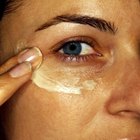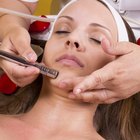Many medical procedures are suggested for stretch marks, but some give better results than others to treat this very difficult scar type. Chemical peels for stretch marks are one option for those who favor topical applications over more invasive procedures, but they can be minimally effective. Although peels lighten the skin, they have little impact on pronounced stretch marks, so different treatments are often more highly recommended.
About Peels
According to the American Academy of Dermatology (AAD), peels improve the skin's general appearance. A chemical solution is applied to the skin that causes the outer layers to separate and slough off.
The solution used in a peel can contain any number of active agents, such as glycolic and lactic acids, which are two types of alpha hydroxy acids, trichloroacetic acid, salicylic acid, which is a type of beta hydroxy acid, or carbolic acid, otherwise known as phenol.
Peels can be light, medium or deep, says the AAD. Generally, peels are used to reduce fine lines on the face, discoloration and mild scar types.
Causes
Stretch marks occur whenever the skin expands to accommodate extra mass, such as during pregnancy, weight gain or during adolescence, when the body grows in rapid spurts.
Skincare expert Paula Begoun, author of numerous books on the topic of skincare, states that stretch marks occur in 90 percent of expectant women, 70 percent of adolescent girls and 40 percent of adolescent males.
Dr. Eric F. Bernstein points out in "The Patient's Guide to Stretch Marks" that hormonal influences that occur along with weight gain are the underlying cause of stretch marks, not just weight gain itself. The Mayo Clinic explains that the cortisone hormone may cause elastin fibers in the skin to break down and stretch marks to form.
Skincare Advice
A series of chemical peels can be considered to treat stretch marks, Paula Begoun says. She states that peels that employ trichloroacetic acid (TCA) at a 20 percent concentration may be more beneficial than those that use weaker alpha hydroxy acids or beta hydroxy acids, as TCA penetrates more deeply into the skin and may encourage collagen and elastin growth.
These peels must be applied by a dermatologist or cosmetic surgeon, Begoun advises.
What Doctors Say
The "Consumer Guide to Plastic Surgery" states that chemical peels, along with procedures such as microdermabrasion, can improve the appearance of stretch marks, make the skin smoother and reduce discoloration. But in a review of various stretch mark treatments, "The Patient's Guide to Stretch Marks" describes peels as "minimally effective."
The reason for this is that damaged elastin, the substance that gives skin its "snap," is extremely difficult to revive. If opting for a chemical peel, the "Consumer Guide to Plastic Surgery" advises choosing a trained physician skilled in this type of treatment. Ask to view pictures of people treated with peels both pre- and post-treatment to get an idea of the results you can expect.
Best Option
The best treatment for stretch marks is a series of laser treatments, says dermatologist Brian Zelickson in "The Patient's Guide to Stretch Marks." Pulsed-dye laser treatment is generally used for newer stretch marks, those that are more lurid in color, while fractional laser therapy is recommended for older, or white, stretch marks.
Laser treatments don't involve a prolonged recovery time, Zelickson says. however, chemical peels and laser treatments aren't cheap. According to the "Consumer Guide to Plastic Surgery," peels cost between $75 and $600. The cost of a single laser treatment varies, but typically starts at $200.
Before deciding on your stretch mark treatment, consult a physician skilled in tackling these scars so you can make the choice that's best for you.
Related Articles

Fraxel Repair Vs. Restore Results

How to Remove Dark Marks From Skin

Homeopathy Cure for Stretch Marks

Instructions for Using Mandelic Acid

The Average Prices for Laser Skin ...

What Are the Dangers of Fraxel Repair?

The Best Facial Moisturizers for People ...

What Are the Dangers of Photofacials?

Fraxel Laser Treatment Dangers

List of Retinoids

Mederma Scar Medication

How to Lighten Birthmarks

Microdermabrasion for the Neck

Face Abrasion Treatment

How to Exfoliate for Rosacea

Side Effects From Skin Tightening

Do Facial Exercises Work Just Like ...

What is the Cause of White Stretch Mark ...

Mesotherapy & Weight Loss Results

How to Decrease Large Pores
References
Writer Bio
Lisa Sefcik has been writing professionally since 1987. Her subject matter includes pet care, travel, consumer reviews, classical music and entertainment. She's worked as a policy analyst, news reporter and freelance writer/columnist for Cox Publications and numerous national print publications. Sefcik holds a paralegal certification as well as degrees in journalism and piano performance from the University of Texas at Austin.